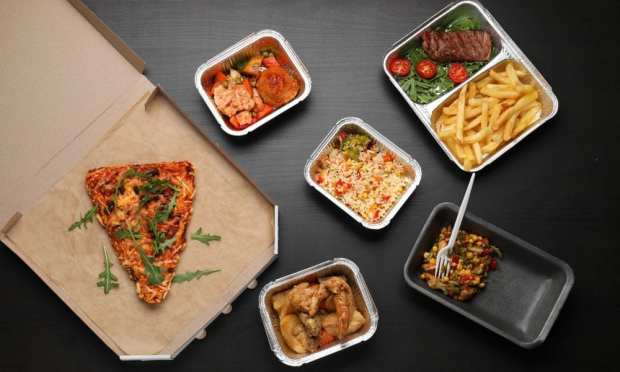Grubhub’s Terrible, Horrible, No Good, Very Bad Day

If bad days are measured by declines in stock market prices, then yesterday (Feb. 7) was a really bad day for Grubhub. It was the day that the online food aggregator announced its earnings, with misses on both revenue and earnings predictions, topped off by guidance that was well below Wall Street estimates.
Investor reaction to the disappointment was swift and brutal. Grubhub shares dropped 21 percent and hit a two-year low. The pressure showed up quite visibly in Grubhub’s earnings figures this time around.
By The Numbers
Grubhub reported a net loss of $5.2 million or $.06 per share in Q4, after earnings of $53.5 million or $.60 per share in the year-earlier period. That miss was brought about by a $4.9 billion tax charge, and adjusted earnings per share (EPS) came in at $.19. Yet, while better than being in the red, that figure came in quite a clip below the adjusted EPS of $.28 from the pre-release forecast.
Revenue increased, rising $287.7 million from $205.1 million at this time last year. Once again, though, it fell below analyst expectations of $290 million in earnings.
On the upside, active diners on the platform ticked up 22 percent to 17.7 million in the quarter, while daily average grubs (orders placed on the platform) were up 19 percent to 467,500.
However, the news that sent the stock price sinking was Grubhub’s forecast for the quarter ahead and the rest of the year. CEO Matt Maloney said the company expects first quarter adjusted earnings before interest, tax, depreciation and amortization (EBITDA) to be between $40 million and $50 million, and for the full year to be between $235 million and $265 million. Analysts were expecting EBITDA to be $58.48 million for the first quarter and $284.16 million for the year — and the big miss on both counts left investors less than delighted.
The Fear Of The Competition
Grubhub operates in an increasingly challenging market. Large players like Uber, with Uber Eats, offer stiff competition and a built-in logistics advantages.
Speaking of logistics, there’s the 800-million-pound gorilla: Amazon, which has been building its own restaurant ordering platform, Amazon Restaurants, and eyeing the space ever-more aggressively, too.
Beyond that, there is the nearly endless stream of venture capital funding, the next big thing in online restaurant order and delivery — further fragmenting the market and making it even more expensive for everyone to compete.
DoorDash raised $250 million in new funding in 2018, and quadrupled its valuation to $4 billion. Postmates raised $300 million — and, as of this week, has filed for an initial public offering (IPO). A few hours after Grubhub reported its earnings, Postmates confirmed on its blog that it had confidentially submitted a draft registration statement on Form S-1 to the U.S. Securities and Exchange Commission (SEC) for its upcoming public offering.
Postmates has claimed that it completes 5 million deliveries per month, and is reportedly expected to record $400 million in revenue in 2018 on food sales of $1.2 billion. It currenly operates in 550 cities.
The pressure to keep up is borne out by Grubhub’s marketing budget for the quarter. The company said it spent $69.9 million on sales and marketing in the Q4, an increase of nearly 54 percent.
Grubhub, faced with so much competition, has had to invest in changing its business model, which has historically relied on restaurants’ own delivery people to get the food to customers. To respond to its competitors, which have delivery fleets as a core offering, Grubhub has been building out its own network of delivery couriers — a move it must make to defend its market share, but one that comes with a big bite out of margins. There’s also the cost to acquire and retain consumers who “game” the system by chasing promo codes and deals that wreak havoc on margins.
Restaurants, meanwhile, have a love-hate relationship with the Grubhub platform (all of them, really). They see orders, but not always profitable ones, with Grubhub’s burgeoning customer list built at their expense.
Jimmy John’s sandwich shop is the latest example, and has claimed to be the first national chain to take a full-throated stand against all the delivery services at once. The company unveiled a new marketing campaign this week in which it vowed to never use delivery apps. It also noted the apps are “notoriously unreliable,” and that it would prefer to handle the whole customer delivery experience with its own fleet, and without third-party interference.
“We want to control the experience, from the fresh prep to the hand off to the customer,” said James North, CEO of Jimmy John’s, in a statement.
The market campaign will feature billboards and online showcasing tweets from dissatisfied customers of third-party food delivery companies.
Squeezed on one side by competition, on another by anxious investors and yet another by restaurateurs, who are apparently mad and not going to take it anymore, Grubhub may have some tough times and fast-thinking ahead. It is certainly a far cry from the reports that were coming out, even last week, that were speculating that Grubhub was on the edge of a big earnings beat — and on the verge of using that win as a springboard for outsized gains moving ahead.
So much for that idea.
